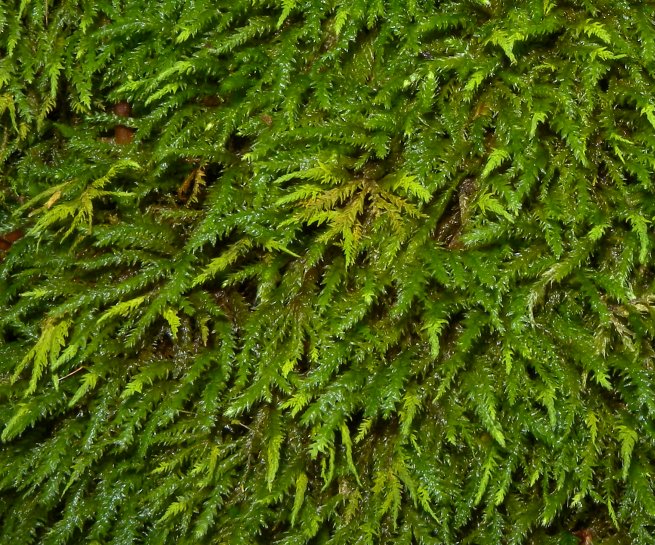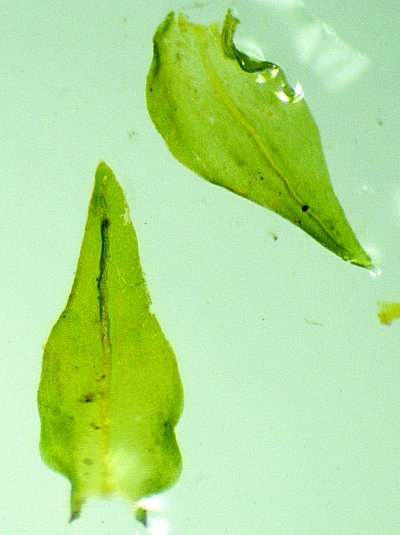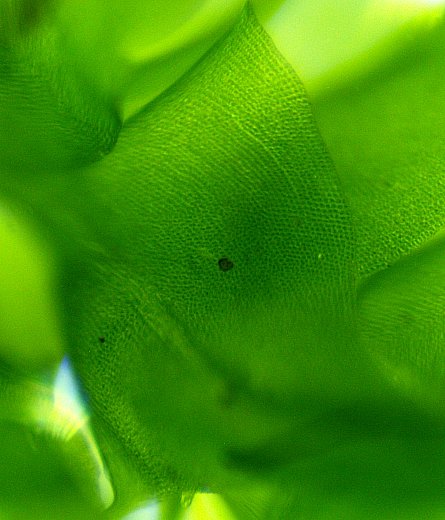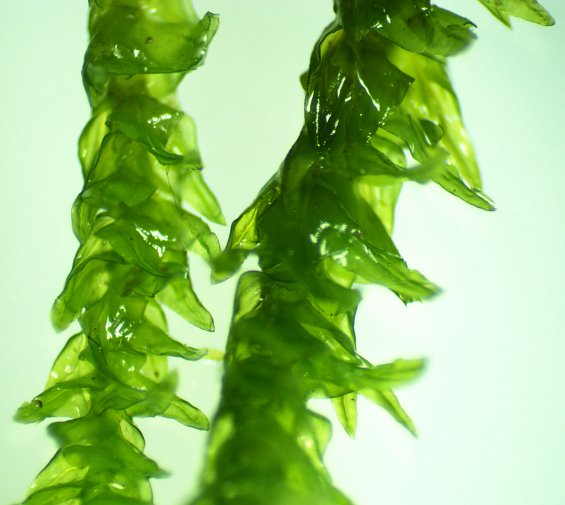
Older leaves are medium green (becoming yellowish green or light brown with age), while young leaves are light green. Young leafy stems are often attenuate; when this occurs, the stems are more slender than usual, while the leaves are dwarfed in size. However, such leafy stems become normal-sized as they age. When the leaves are moist, they spread from the stems at about a 45° angle; they also become more shiny and somewhat 2-ranked in appearance along the stems. Moist leafy stems appear somewhat flattened. When the leaves are dry, they become erect along the stems, more incurved, and somewhat crumpled; dry leafy stems appear stringy, irregularly curved, and dull-colored. The tips of dry leafy stems may become shaped like little balls. Most leaf cells are irregularly hexagonal in shape and green in appearance. However, the center-bottom area of each leaf has cells that are more elongated in shape and they are more translucent. Individual cells have multiple minute bumps (papillae) on their surfaces. This moss is dioicous, forming male reproductive organs (antheridia) and female reproductive organs (archegonia) on separate plants. These reproductive organs occur in the axils of leaves. On rare occasions, female plants will be successfully fertilized by the sperm, resulting in the development of sporophytes.

The slender setae (stalks) of these sporophytes are 1–1.5 cm. long, terete, and more or less erect. Spore-bearing capsules occur at the apices of the setae, and they are held more or less erect. The capsule bodies are 2–2.5 mm. long and oblongoid-cylindrical in shape; their lids are 1–1.5 mm. long (including their tilted beaks). Covering the capsule bodies and their lids are membranous hairless hoods (calyptrae) that are beaked; these hoods soon split apart and fall to the ground. When a lid detaches from a capsule and falls to the ground, a ring of teeth (peristome) is revealed along the perimeter of the capsule's mouth; these teeth regulate the release of spores to the wind. Individual spores are 9-12 micrometers across and minutely bumpy (papillose). Brownish fibrous rhizoids develop at intervals along the primary stems that lie on the substrate; they anchor the leafy stems to the substrate. This moss can reproduce asexually from fragments of leafy stems. When the stems of such fragments touch a moist substrate, they are able to develop new rhizoids.
Cultivation: The preference is light to medium shade, moist to dry-mesic conditions, and either ordinary soil, rocks with pockets of organic debris, or tree bark. The soil can contain loam, clay, and/or humus, while the rocky substrate can consist of limestone, dolomite, or sandstone. Because of its low habit of growth, this moss doesn't tolerate much competition from taller plants.

Range & Habitat: Common Tree-skirt Moss (Anomodon attenuatus) is occasional to locally common throughout Illinois (see Distribution Map), where it is native. This moss is widely distributed in North America, Europe, and scattered parts of Asia. In Illinois, habitats include ground soil in deciduous woodlands, earthen banks along woodland paths, ground soil at the base of trees, lower trunks of trees, rotten logs in wooded areas, slopes of wooded hillsides, shaded ground on sandstone bluffs, shaded slopes along ravines, shaded ground in rocky canyons, shaded sandstone outcrops, shaded dolomite cliffs, wet sandstone cliffs & boulders, rocks at the head of springs, shaded rocks along streams, and areas along highways. This moss is typically associated with various deciduous trees, including Sugar Maple (Acer saccharum), American Basswood (Tilia americana), American Sycamore (Platanus occidentalis), Northern Red Oak (Quercus rubra), and other oaks (Quercus spp.). In Illinois, Common Tree-skirt Moss usually occurs in natural areas of moderate to high quality.

Faunal Associations: The dense mats of foliage provide cover for small insects and other invertebrates. The foliage of Common Tree-skirt Moss (Anomodon attenuatus) was often used as construction material for the nests of the Prothonotary Warbler (Protonotaria citrea) in Virginia (Blem & Blem, 1994). Because of this kind of activity, songbirds may be responsible, in part, for spreading this moss from one tree or area to another, as it rarely produces spore-bearing capsules.
Photographic Location: An earthen mound along a woodland path at the Shades State Park in west-central Indiana. Close-up photos were also taken indoors using either a microscope or a camera with a flash.

Comments: There are several Tree-skirt mosses (Anomodon spp.) in Illinois, but only about 3 of them are fairly common within the state. Common Tree-skirt Moss (Anomodon attenuatus) can be distinguished from other Tree-skirt mosses by the prominent attenuated tips on its actively growing leafy stems; they have very slender stems and dwarfed leaves that later become normal-sized. Other Tree-skirt mosses have leafy stem tips that are more blunt and normal-sized. The individual leaves of Common Tree-skirt Moss have acute or narrowly rounded tips, sometimes with a few minute teeth. Other Tree-skirt mosses have leaves with more broadly rounded leaf tips that lack teeth. A notable exception is Anomodon rostratus, as its leaves have tips that are more elongated and narrowly acute. In addition to the shape of their leaf tips, Tree-skirt mosses differ in their leaf sizes (0.5-1 mm. or 1-2 mm. or 2-3 mm. in length) and how far the midribs extend to their leaf tips. Common Tree-skirt Moss also resembles Graceful Chain Moss (Leskea gracilescens). This latter species can be distinguished by its smaller leaves (less than 1 mm. long) and the shorter conical lids (less than 1 mm. long) on its spore-bearing capsules. Another distinction between these two species, which is only visible using a high-powered microscope, are the number of minute bumps (papillae) per leaf cell. Common Tree-skirt Moss has 2 or more minute bumps per leaf cell, while Graceful Chain Moss has only 1 minute bump per leaf cell. Other common names of Anomodon attenuatus are Common Tree Apron Moss, Slender Tail-moss, and Poodle Moss.